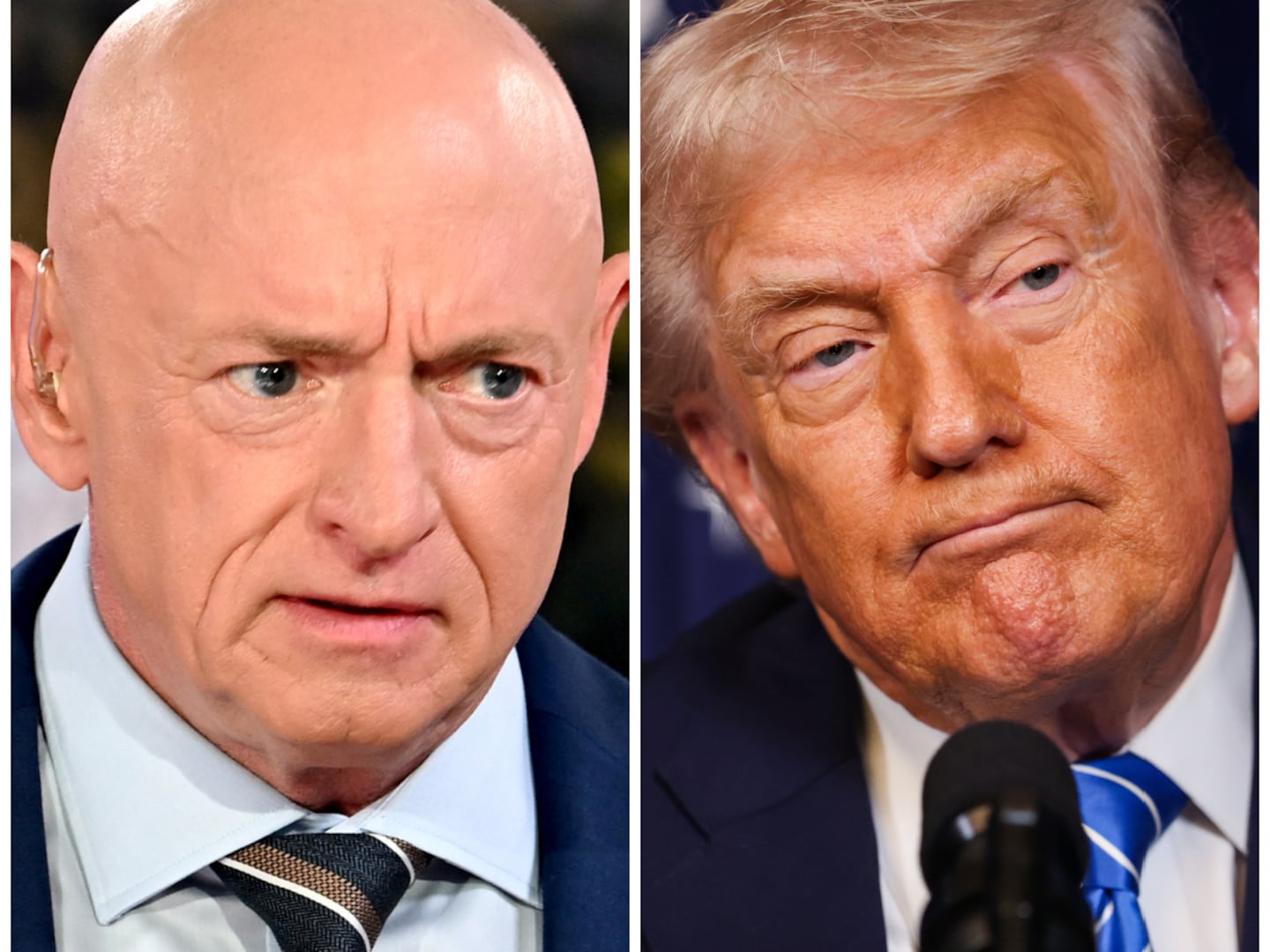As talks between the United States and North Korea continue, Donald Trump insists that North Korea is making a good-faith effort to denuclearize.
U.S. intelligence officials now say the opposite, however. As one official told NBC last week, “There is absolutely unequivocal evidence that they are trying to deceive the U.S.”
But it’s still very early in the negotiation process—the Iran nuclear deal took years to hammer out—and U.S. Secretary of State Mike Pompeo is due to travel to Pyongyang this weekend.
So as negotiations continue, how can observers know if the North Koreans are actually interested in compromise? The Daily Beast spoke with former administration officials familiar with the North Korea negotiation process about how to tell when North Korean leader Kim Jong Un is bluffing.
If Pyongyang is truly prepared to denuclearize, said Abigail Grace, a former National Security Council staff member under the Trump administration, the very next step in the process will be that they will submit a complete list of nuclear sites. Yongbyon is the country’s primary nuclear research facility, but it’s long been suspected that there are other undisclosed fuel enrichment sites. In the lead-up to the Trump-Kim summit in Singapore, satellite imagery showed that some structures at the Punggye-Ri test site had been demolished. But U.S. intelligence officials have said that North Korea has actually ramped up nuclear production at other facilities and that they are actively trying to conceal those locations.
Conversely, submitting an incomplete list would be the first of several telltale signs that the communist country has no intention to pursue denuclearization, said Grace, who worked on the Asia portfolio at the NSC. “That’s how the framework broke down in the 2000s. What they submitted was not actually complete.”
Christopher Hill, who led the U.S. delegation to the six-party talks during the George W. Bush administration, explained that the lack of transparency about facilities was one factor that derailed negotiations.
“Back in 2005, we tried to get a verification protocol, but they were way too restrictive on verification,” said Hill. “They were limiting us to facilities that we already knew all about.” The U.S. suspected that they were hiding a uranium enrichment program, though the North Koreans later denied it; in 2010, after the six-party talks had collapsed, Pyongyang unveiled a sophisticated uranium enrichment facility (PDF).
Another sign is if Pyongyang attempts to extend trust-building measures indefinitely and to delay explicit commitments. “If it’s 2019 and we haven’t seen a full declaration of nuclear test sites or a concrete timeline [for denuclearization], then it’s fair to say they don’t intend to take this process seriously,” said Grace.
Third, frequently canceling scheduled meetings would be another sign that the whole process is a sham. And that doesn’t mean canceling more Trump-Kim summits, but rather the mid-level meetings where the real work is done.
“They might even try to stall by having more of these higher level meetings,” said Grace. “If they relegate contact to only that upper channel, then they can convince U.S. policy makers that they are making progress when they might not be.”
And finally, if Kim increases his outreach to Chinese President Xi Jinping and Russian President Vladimir Putin, that could indicate that he intends to use them as buffers when the United States asks for concrete steps toward denuclearization. In June, Kim made his third trip to China in three months, making Xi the foreign leader that Kim has met most frequently.
Of course, it seems highly unlikely that there will be real disarmament. As Jeffrey Lewis, a nonproliferation expert at the Middlebury Institute of International Studies, notes, North Korea has never offered to give up its weapons. Instead, Pyongyang has only spoken of “denuclearization”—a term referring to the United States stepping back from its nuclear security commitments to South Korea in exchange for detente with the North.
“If I were North Korea, I wouldn’t give up nuclear weapons,” said Lewis. “Saddam gave up his weapons and he died. Gaddafi gave up his weapons and he died.
“The time to stop them was before they had the weapons. I think they’d be crazy to give them up.”
But a strategic shift isn’t impossible. There are ways to manage the risk and to aim for agreements that would still place some limits on Pyongyang’s behavior, though seeking those would involve giving up the black and white thinking of demanding full disarmament. As Lewis said, “There are still things we can do.”
That involves accepting that North Korea has become a nuclear-armed power, and working to limit the number and types of weapons it has, rather than prolonging the instability and brinksmanship that comes from attempting to strong-arm it into taking steps it will never willingly take. Demanding total disarmament is particularly risky under a president as volatile as Trump, who may sideline Pompeo in favor of the more hawkish national security adviser John Bolton.
Satellite imagery taken June 21 revealed that North Korea had continued to make significant infrastructure improvements to the Yongbyon facility. Additional images from Planet Labs in California, revealed early this week, indicates that construction has continued at a facility in the city of Hamhung that produces parts for solid-fueled missiles. Solid-fueled missiles, unlike liquid-fueled, are easier to transport (and thus to hide), and the regime has previously demonstrated a solid-fuel missile range of over 1,000 miles. So North Korea is still expanding test sites, rather than dismantling them.
That’s not terribly surprising—except, perhaps, to those who believed Trump’s June 13 tweet declaring that “there is no longer a nuclear threat from North Korea.”
An agreement to place limits on nuclear tests involves a carefully negotiated framework of clear incentives, and that framework has not yet been created—meaning that the benefits of dismantling or freezing a hard-won weapons program haven’t yet materialized. As analysts at the North Korea analysis website 38North wrote, “Continued work at the Yongbyon facility should not be seen as having any relationship to North Korea’s pledge to denuclearize. The North’s nuclear cadre can be expected to proceed with business as usual until specific orders are issued from Pyongyang.”
And those orders won’t be issued until a clear decision is made to do so. “Why would they start magically dismantling their weapons if they don’t understand what their incentives are already?” said Grace.
“It’s a step-by-step process whether John Bolton likes that or not,” said Hill.
“What the U.S. is trying to do is to test the proposition that they are prepared to denuclearize. If they are prepared to denuclearize, their goal should be to give us a complete list of their programs,” said Hill. “The next step should be a listing of their entire program, and then, beyond that, a kind of road map for dealing with it.”
Pompeo’s meeting with Kim this weekend in Pyongyang is a good step in this direction, said Hill. Pompeo “needs to sit down with North Koreans and discuss this road map,” said Hill. In terms of the continued construction on nuclear sites, it could simply be “the merry-go-round taking a little time to stop, or it could be willful subterfuge.”
“We have to see what is the upshot of the visit by Pompeo,” Hill said. “It would be prudent to wait and see what he comes back with.”
If Kim is, in fact, serious about trying to meet the United States somewhere in the middle, even if that doesn’t mean actual disarmament, diversifying the level of political contact could be another sign—working on expanding its overseas missions, for example—or in other words, “acting like a normal country,” Grace told The Daily Beast.
Further steps toward economic liberalization, such as infrastructure projects and joint factories, would be another sign.
But full denuclearization? That’s probably a pipe dream.
“I just think we’re focused on the wrong thing,” said Lewis. “We’re trying to get back to the 1990s rather than living in the reality of 2018.”






